Hyung Jun Koo
PhD, Chemical Engineering, 2012 | 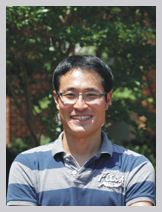 |
Research Focus: Soft Electronics Based on Water Gels
Soft Matter Diodes
Our group has reported that a new type of ionic rectifying junction can be formed at the interface of two water-based gels doped with polyelectrolytes of opposite charge (Figure 1). The remarkable feature of these rectifying junctions is that they operate on the basis of water-borne ions. The unidirectional current response at the interface between the cationic and anionic gels originates from anisotropy in the mobile ionic charges in the gels. The current depends on the concentration of polyelectrolyte, the background ionic concentration, and the distance traveled by the ions. Even though our devices were first-generation prototypes without any optimization, the gel diodes had comparable or higher current densities and rectification ratios than other organic polymer-based electronic devices (Figure 1). These water gel diodes had good long-term stability in both DC and AC conduction modes.

Figure 1: Schematics of the diodes with the gel/gel interface and plot showing the I-V characteristics of the devices.
Highly efficient rectifying junction was observed at the interface between SiO2 and aqueous gel[1]. Figure 2 shows the schematic of the SiO2/gel interface diode. SiO2 thin film, which has non-linear conductivity, controls the ionic current flows unidirectionally. Since the polymer matrix of the gel has slightly charged backbones, the gel materials increase the ion conductivity by facilitating the ionic transport. Addition of the salt or polyelectrolyte to the gel improves the current density and rectifying performance. This diode structure based on the SiO2/hydrogel interface exhibits high rectification ratio of more than 30,000, which is comparable to, or even higher than, that of inorganic p-n junction diode (Figure 2). The gels are flexible, biocompatible and environmentally friendly. The materials and the process of preparation of these devices are very simple, inexpensive and scalable. Such device could be used in bioelectronic circuits, liquid sensors, bio-fuel cells and biomimetic photovoltaics.
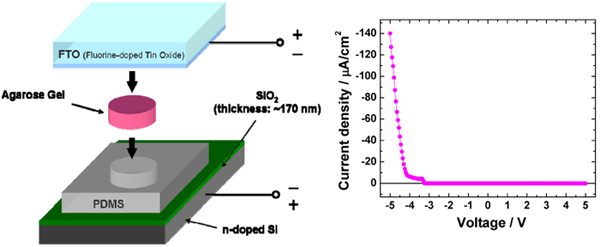
Figure 2: Schematics of the diodes based on the aqueous gel/SiO2 interface and plot showing I-V characteristic of a prototype diode.
Hydrogel Solar Cells
My second project is to design and characterize new photovoltaic devices that are based on aqueous gels (Figure 3). The gel is not only a soft and flexible material but also a good medium for biologically derived molecules. Such biocompatible gel material would be a key component to achieve our overarching goal, fabrication of photovoltaics that mimic an artificial leaf.
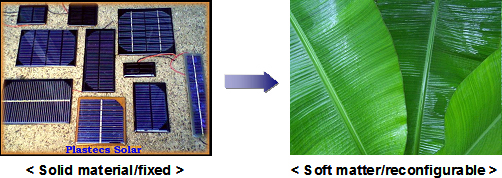
Figure 3: The overarching goal of the gel solar cell project.
We fabricated a new type of photovoltaic systems based on aqueous soft gel materials[2]. Two photosensitive ions, DAS– and [Ru(bpy)3]2+, were used as photoactive molecules embedded in aqueous gel. The hydrogel photovoltaic devices showed performance comparable with or higher than those of other biomimetic or ionic photovoltaic systems reported recently. We could reduce the cost of the device fabrication by replacing the expensive Pt counter-electrode with copper coated with carbon materials, such as carbon nanotubes, carbon black or graphite. Finally, we constructed prototypes of flexible and low cost photovoltaic cells based on aqueous gels (Figure 4). Biologically derived photoactive molecules, such as Chlorophyll and Photosystem II, were successfully operated in water gel media of the device.
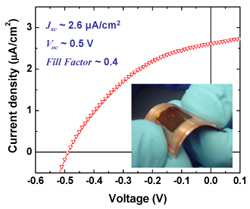
Figure 4: Plot showing the performance and photograph of a prototype aqueous gel based solar cell.
Quasi-Liquid Diodes and Memristors Based on Hydrogel and a Liquid Metal
New types of electronic devices and circuits based on soft materials have potential applications in bio-electronic circuits, artificial neural networks, and brain-machine interfaces. The objective of this project is to develop a new class of diodes and memristors composed entirely of soft materials formed by combining a moldable liquid metal and hydrogel doped with polyelectrolytes. The electronic functionality of these devices originates from the ability to control the electronic and ionic transport at the interface between the metal and the hydrogel. We fabricated soft and quasi-liquid diodes and memristors (Figure 5), by sandwiching two hydrogel films: one doped with polyacrylic acid (PAA) and one doped with polyethyleneimine (PEI)[3, 4].
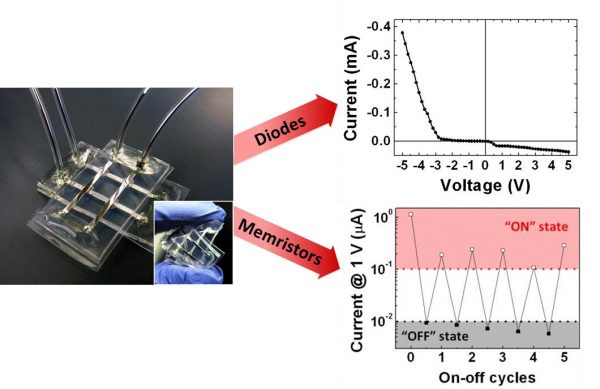
Figure 5: A prototype circuit device with cross bar array of entirely soft material-based diodes and memristors (left). Representative I-V curves show the rectification and the switching performance of the device (right).
We contacted both sides of the stack with liquid metal electrodes. The PEI-doped hydrogel suppresses the oxidation reaction at the electrode interface, whereas the thickness of the oxide layer at the interface with the PAA-doped hydrogel can be controlled by applying an electric bias. The direction and the magnitude of the electric bias control the anisotropy of current conductance, resulting in tunable rectification ratios. The pre-programmed anisotropy is preserved for more than an hour, which enables the fabrication of memory storage devices.
Publications
So, J.-H.; Koo, H.-J.; Dickey, M. D.; Velev, O. D.; Ionic Current Rectification in Soft Matter Diodes with Liquid Metal Electrodes. Advanced Functional Materials Accepted.
News Reports
NCSU press
“Mimicking Nature, Water-Based ‘Artificial Leaf’ Produces Electricity” September, 2010
“Soft Memory Device Opens Door To New Biocompatible Electronics” July, 2011
Science Daily
“Mimicking Nature, Water-Based ‘Artificial Leaf’ Produces Electricity” September, 2010
“Soft Memory Device Opens Door To New Biocompatible Electronics” July, 2011
Physorg
“Leaf-like solar cells: Water-Based ‘Artificial Leaf’ Produces Electricity” September, 2010
The Epoch Times
“Water-Based Artificial Leaf Produces Electricity” September, 2010
Nanowerk
“Soft Memory Device Opens Door To New Biocompatible Electronics” July, 2011
Science Blog
“Soft Memory Device Opens Door To New Biocompatible Electronics” July, 2011
Wired.co.uk
“Jelly-like memory device could interact with your cells” July, 2011
Physics News
“Soft Memory Device Opens Door To New Biocompatible Electronics” July, 2011
C&EN
“’Artificial Leaf’ Produces Electricity” October, 2010
Highlight in Chemical Science (Royal Society of Chemistry)
“Mimicking nature’s solar cells” October, 2010
The Dong-a Ilbo
“Leaf produces Electricity?” November, 2010
CEP
“Water-Based “Artificial Leaf” Produces Electricity” November, 2010
Photonic spectra
“Mimicking nature to build a better solar cell” December, 2010
redOrbit
“Mimicking Nature, Water-Based ‘Artificial Leaf’ Produces Electricity” September, 2010
“Soft Memory Device Opens Door To New Biocompatible Electronics” July, 2011
